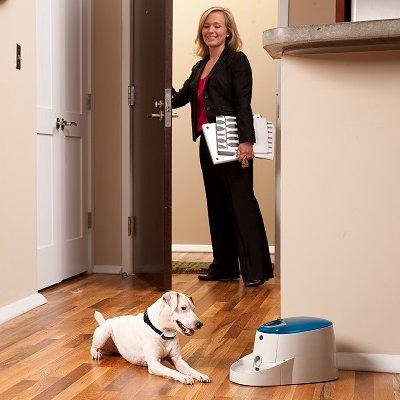
What Should I Do If My Dog Has Separation Anxiety?
Dogs with separation anxiety panic when left alone. Common signs include going to the bathroom in the house, destruction, barking, whining, howling, and even hurting themselves. Once diagnosed, treatment with extensive behavior modification and sometimes anti-anxiety medications can lead to successful management of the problem.
Don't Leave Your Dog Alone at First

When separation anxiety is severe, be prepared for treatment to take many months. The first step is avoidance. Your dog should not be left alone if at all possible. This keeps your dog safe so he doesn't hurt himself and prevents your dog from practicing anxious behavior. We want to change his emotional response to being home alone to a more positive one, so we want to control his experiences at home alone.
Start independence exercises. Place your dog in a Stay position on a bed or blanket with his favorite long-lasting treat such as frozen peanut butter stuffed in a Kong or Busy Buddy® Squirrel Dude™ toy. Gradually over many sessions move farther away from your dog for longer periods of time. If your dog is resting with head down or chewing on the treat, extend the time and distance you're away. If your dog gets up or is staying because he is well-trained but not resting or chewing his treat, then decrease the time and distance you move away. Your dog being relaxed is key to changing his emotional response to your absence.
Practice Leaving & Returning Home

Next, perform activities that signal to your dog you are leaving the house at times you have no intention of leaving. For example, jingle your keys and then go wash dishes. Gradually start to add more activities and perform them together, only progressing when your dog is calm. The goal is for your dog to no longer associate these activities with your departure.
Once you can walk around your house for 10 minutes and your dog remains on his bed chewing on his toy, you can walk out the door. Sometimes it helps to use a different door for these exercises than you normally leave through. The door designated for these exercises becomes a safety cue for your dog, indicating that you will come back before he starts to get anxious. Stagger the amount of time you are gone (e.g., 10 seconds, 30 seconds, 5 seconds, 45 seconds) so it's not predictable to your dog. Only increase the amount of time if your dog is calm, relaxed, and chewing on his toy while you're gone. When you work up to longer amounts of time, leave multiple long-lasting treats for your dog to find and chew on in your absence.
It's also helpful to ignore your dog for 10 minutes before leaving and wait until he's calm before paying attention to him after you return home. These times can be emotionally charged for dogs with separation anxiety and ignoring him helps to keep the tone relaxed rather than inadvertently rewarding over the top behavior.
Consider Anti-Anxiety Medication for Severe Cases

Finally, anti-anxiety medications may be prescribed by your veterinarian. These medications alone will not solve the problem, but can help make it easier to continue behavior modification.
Separation anxiety can be very stressful for the dog and owner, but successful treatment is possible once an accurate diagnosis has been made. With dedication, the problem can be well-managed. If your dog is has been diagnosed with separation anxiety, set up an appointment with your veterinarian or a veterinary behaviorist today to help guide you through an individual treatment plan.
Get Email Updates
Subscribe to the latest news, promotions, & more from PetSafe® brand.
Sign up today for the latest news, promotions, and more from PetSafe® brand.









